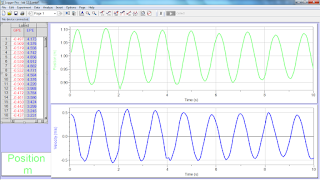3) Elastic collisions are both which the momentum and the kinetic energy are both conserved. The total energy system before the collision equals the total energy after the collision. If some energy were to be lost after the collision, then our definition would be inelastic collisions. Elastic collisions can also be conserved by solving it using the center-of-mass frame of reference. The frame of reference is from the perspective of the lab.
4)


 We will determine a lab to see if we can make an elastic collision conservative. Here we have a lab setup of 3 balls on stop on a leveled glass table. We will determine two experiments. The first will be two balls with the same mass will bounce each other off and the second of a steel ball with the greatest mass hitting a stationary ball. We will record the lab using a smartphone and modify the speed so we can determine the velocity to punch into our equation. Here is a before and after pictures of the collisions from the balls.
We will determine a lab to see if we can make an elastic collision conservative. Here we have a lab setup of 3 balls on stop on a leveled glass table. We will determine two experiments. The first will be two balls with the same mass will bounce each other off and the second of a steel ball with the greatest mass hitting a stationary ball. We will record the lab using a smartphone and modify the speed so we can determine the velocity to punch into our equation. Here is a before and after pictures of the collisions from the balls.Marble vs Marble

Before

The moment it collides

After
Steel ball vs Marble

Before

The moment the balls collide

After
5)This is the data of two marbles with the same mass. The way we determine the velocity data from the balls was by indicating dots on both balls over time, then the software derived the equations to solve the data into velocity vs time. The boxes indicated in the graphs are the average velocity before and after the collision.
Marble vs Marble


Steel vs Marble


6) Marble vs Marble




Steel vs Marble




7) Marble vs Marble Graphs
On the first graph, it indicates position vs time with the two balls that collide against each other. One ball is stationary and the other ball is heading towards it. The green dots on the horizontal line indicates the ball wasn't moving before the collision. After the collision, the graph illustrates the ball moving into different directions and different speeds. The second graph illustrates the velocity of both marbles before and after the collision. The third and fourth graph illustrates the center of mass in displacement and velocity form.
Steel vs Marble
This experiment, its the steel ball heading towards a stationary marble ball. As you can see on the first graph of position vs time, the red dots indicating the steel ball still has the same rate even after the collision. This shows the heavy mass still continues towards its path even after the collision. On the velocity graph for the marble ball, it shows the marble is almost at the same speed as the steel ball.
8) After writing down the data, we wrote down the equations for kinetic energy and conservation of momentum to see if the collisions were elastic. The results were slightly similar;although they weren't exactly equal each other. This shows in the kinetic energy, energy was lost.


































